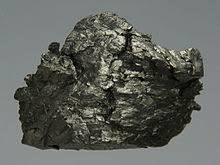Rare Metals
Rare Metals or Rare Earth Elements or Rare Earth Metals are a set of seventeen chemical elements. Rare Earth Elements, due to their geochemical properties, are typically dispersed and not often found in concentrated and economically exploitable forms. The few economically exploitable deposits are known as Rare Earth Minerals.
Name: Scandium
 Atomic Number: 21
Symbol: Sc
History: It got its name from Latin Scandia (Scandinavia), where the first rare earth ore was discovered.
Applications/Uses: Light aluminium-scandium alloy for aerospace components, additive in Mercury-vapor lamps.
Atomic Number: 21
Symbol: Sc
History: It got its name from Latin Scandia (Scandinavia), where the first rare earth ore was discovered.
Applications/Uses: Light aluminium-scandium alloy for aerospace components, additive in Mercury-vapor lamps.
Name: Yttrium
 Atomic Number: 39
Symbol: Y
History: It has been named after the village of Ytterby, Sweden, where the first rare earth ore was discovered.
Applications/Uses: Yttrium-aluminium garnet (YAG) laser, yttrium vanadate (YVO4) as host for europium in TV red phosphor, YBCO high-temperature superconductors, yttrium iron garnet (YIG) microwave filters.
Atomic Number: 39
Symbol: Y
History: It has been named after the village of Ytterby, Sweden, where the first rare earth ore was discovered.
Applications/Uses: Yttrium-aluminium garnet (YAG) laser, yttrium vanadate (YVO4) as host for europium in TV red phosphor, YBCO high-temperature superconductors, yttrium iron garnet (YIG) microwave filters.
Name: Lanthanum
 Atomic Number: 57
Symbol: La
History: It got its name from the Greek �lanthanein�, meaning to be hidden.
Applications/Uses: High refractive index glass, flint, hydrogen storage, battery-electrodes, camera lenses, fluid catalytic cracking catalyst for oil refineries
Atomic Number: 57
Symbol: La
History: It got its name from the Greek �lanthanein�, meaning to be hidden.
Applications/Uses: High refractive index glass, flint, hydrogen storage, battery-electrodes, camera lenses, fluid catalytic cracking catalyst for oil refineries
Name: Cerium
 Atomic Number: 58
Symbol: Ce
History: It has been named after the dwarf planet Ceres, named after the Roman goddess of agriculture.
Applications/Uses: Chemical oxidizing agent, polishing powder, yellow colors in glass and ceramics, catalyst for self-cleaning ovens, fluid catalytic cracking catalyst for oil refineries, ferrocerium flints for lighters
Atomic Number: 58
Symbol: Ce
History: It has been named after the dwarf planet Ceres, named after the Roman goddess of agriculture.
Applications/Uses: Chemical oxidizing agent, polishing powder, yellow colors in glass and ceramics, catalyst for self-cleaning ovens, fluid catalytic cracking catalyst for oil refineries, ferrocerium flints for lighters
Name: Praseodymium
 Atomic Number: 59
Symbol: Pr
History: It got its name from the Greek �prasios�, meaning leek-green, and �didymos�, meaning twin.
Applications/Uses: Rare-earth magnets, lasers, core material for carbon arc lighting, colorant in glasses and enamels, additive in didymium glass used in welding goggles,[4] ferrocerium firesteel (flint) products.
Atomic Number: 59
Symbol: Pr
History: It got its name from the Greek �prasios�, meaning leek-green, and �didymos�, meaning twin.
Applications/Uses: Rare-earth magnets, lasers, core material for carbon arc lighting, colorant in glasses and enamels, additive in didymium glass used in welding goggles,[4] ferrocerium firesteel (flint) products.
Name: Neodymium
 Atomic Number: 60
Symbol: Nd
History: It got its name from the Greek �neos�, meaning new, and �didymos�, meaning twin.
Applications/Uses: Rare-earth magnets, lasers, violet colors in glass and ceramics, ceramic capacitors
Atomic Number: 60
Symbol: Nd
History: It got its name from the Greek �neos�, meaning new, and �didymos�, meaning twin.
Applications/Uses: Rare-earth magnets, lasers, violet colors in glass and ceramics, ceramic capacitors
Name: Promethium
 Atomic Number: 61
Symbol: Pm
History: It has been named after the Titan Prometheus, who brought fire to mortals.
Applications/Uses: Nuclear batteries
Atomic Number: 61
Symbol: Pm
History: It has been named after the Titan Prometheus, who brought fire to mortals.
Applications/Uses: Nuclear batteries
Name: Samarium
 Atomic Number: 62
Symbol: Sm
History: It has been named after Vasili Samarsky-Bykhovets, who discovered the rare earth ore samarskite.
Applications/Uses: Rare-earth magnets, lasers, neutron capture, masers
Atomic Number: 62
Symbol: Sm
History: It has been named after Vasili Samarsky-Bykhovets, who discovered the rare earth ore samarskite.
Applications/Uses: Rare-earth magnets, lasers, neutron capture, masers
Name: Europium
 Atomic Number: 63
Symbol: Eu
History: It has been named after the continent of Europe.
Applications/Uses: Red and blue phosphors, lasers, mercury-vapor lamps, NMR relaxation agent.
Atomic Number: 63
Symbol: Eu
History: It has been named after the continent of Europe.
Applications/Uses: Red and blue phosphors, lasers, mercury-vapor lamps, NMR relaxation agent.
Name: Gadolinium
 Atomic Number: 64
Symbol: Gd
History: It has been named after Johan Gadolin (1760�1852), to honor his investigation of rare earths.
Applications/Uses: Rare-earth magnets, high refractive index glass or garnets, lasers, X-ray tubes, computer memories, neutron capture, MRI contrast agent, NMR relaxation agent.
Atomic Number: 64
Symbol: Gd
History: It has been named after Johan Gadolin (1760�1852), to honor his investigation of rare earths.
Applications/Uses: Rare-earth magnets, high refractive index glass or garnets, lasers, X-ray tubes, computer memories, neutron capture, MRI contrast agent, NMR relaxation agent.
Name: Terbium
 Atomic Number: 65
Symbol: Tb
History: It has been named after the village of Ytterby, Sweden.
Applications/Uses: Green phosphors, lasers, fluorescent lamps
Atomic Number: 65
Symbol: Tb
History: It has been named after the village of Ytterby, Sweden.
Applications/Uses: Green phosphors, lasers, fluorescent lamps
Name: Dysprosium
 Atomic Number: 66
Symbol: Dy
History: It got its name from the Greek �dysprositos�, meaning hard to get.
Applications/Uses: Rare-earth magnets, lasers
Atomic Number: 66
Symbol: Dy
History: It got its name from the Greek �dysprositos�, meaning hard to get.
Applications/Uses: Rare-earth magnets, lasers
Name: Holmium
 Atomic Number: 67
Symbol: Ho
History: It has been named after Stockholm (in Latin, �Holmia�), native city of one of its discoverers.
Applications/Uses: Lasers
Atomic Number: 67
Symbol: Ho
History: It has been named after Stockholm (in Latin, �Holmia�), native city of one of its discoverers.
Applications/Uses: Lasers
Name: Erbium
 Atomic Number: 68
Symbol: Er
History: It has been named after the village of Ytterby, Sweden.
Applications/Uses: Lasers, vanadium steel
Atomic Number: 68
Symbol: Er
History: It has been named after the village of Ytterby, Sweden.
Applications/Uses: Lasers, vanadium steel
Name: Thulium
 Atomic Number: 69
Symbol: Tm
History: It has been named after the mythological northern land of Thule.
Applications/Uses: Portable X-ray machines
Atomic Number: 69
Symbol: Tm
History: It has been named after the mythological northern land of Thule.
Applications/Uses: Portable X-ray machines
Name: Ytterbium
 Atomic Number: 70
Symbol: Yb
History: It has been named after the village of Ytterby, Sweden.
Applications/Uses: Infrared lasers, chemical reducing agent
Atomic Number: 70
Symbol: Yb
History: It has been named after the village of Ytterby, Sweden.
Applications/Uses: Infrared lasers, chemical reducing agent
Name: Lutetium
 Atomic Number: 71
Symbol: Lu
History: It has been named after Lutetia, the city which later became Paris.
Applications/Uses: PET Scan detectors, high refractive index glass.
Atomic Number: 71
Symbol: Lu
History: It has been named after Lutetia, the city which later became Paris.
Applications/Uses: PET Scan detectors, high refractive index glass.
Name: Rhenium
 Atomic Number: 75
Symbol: Re
Rarity: 0.7 ppb
History: Discovered in 1925, rhenium was the last stable element to be discovered. It was named after the river Rhine in Europe.
Applications/Uses: Rhenium is added to high-temperature super alloys that are used to make jet engine parts, using 70% of the worldwide rhenium production. Another major application is in platinum-rhenium catalysts, which are primarily used in making lead-free, high-octane gasoline.
Atomic Number: 75
Symbol: Re
Rarity: 0.7 ppb
History: Discovered in 1925, rhenium was the last stable element to be discovered. It was named after the river Rhine in Europe.
Applications/Uses: Rhenium is added to high-temperature super alloys that are used to make jet engine parts, using 70% of the worldwide rhenium production. Another major application is in platinum-rhenium catalysts, which are primarily used in making lead-free, high-octane gasoline.
Name: Iridium
 Atomic Number: 77
Symbol: Ir
Rarity: 1 ppb
History: Iridium was discovered in 1803 among insoluble impurities in natural platinum. Smithson Tennant, the primary discoverer, named the iridium for the goddess Iris.
Applications/Uses: electronics-related; iridium crucibles are commonly used for growing large high-quality single crystals; spark plugs; electrodes for the chloralkali process; and chemical catalysts.
Atomic Number: 77
Symbol: Ir
Rarity: 1 ppb
History: Iridium was discovered in 1803 among insoluble impurities in natural platinum. Smithson Tennant, the primary discoverer, named the iridium for the goddess Iris.
Applications/Uses: electronics-related; iridium crucibles are commonly used for growing large high-quality single crystals; spark plugs; electrodes for the chloralkali process; and chemical catalysts.
Name: Rhodium
 Atomic Number: 45
Symbol: Rh
Rarity: 1 ppb
History: Rhodium was discovered in 1803 by William Hyde Wollaston in an ore of platinum or nickel, and was named for the rose color of one of its chlorine compounds, produced after it reacted with the powerful acid mixture aqua regia.
Applications/Uses: catalytic converter; glass industry, mostly for production of fiberglass and flat-panel glass; Rhodium detectors are used in nuclear reactors to measure the neutron flux level.
Atomic Number: 45
Symbol: Rh
Rarity: 1 ppb
History: Rhodium was discovered in 1803 by William Hyde Wollaston in an ore of platinum or nickel, and was named for the rose color of one of its chlorine compounds, produced after it reacted with the powerful acid mixture aqua regia.
Applications/Uses: catalytic converter; glass industry, mostly for production of fiberglass and flat-panel glass; Rhodium detectors are used in nuclear reactors to measure the neutron flux level.
Name: Ruthenium
 Atomic Number: 44
Symbol: Ru
Rarity: 1 ppb
History: Russian scientist, Karl Ernst Claus, discovered the element in 1844 and named it after Ruthenia, the Latin word for Rus� (ancient Russia).
Applications/Uses: used for wear-resistant electrical contacts and the production of thick-film resistors; platinum alloys.
Atomic Number: 44
Symbol: Ru
Rarity: 1 ppb
History: Russian scientist, Karl Ernst Claus, discovered the element in 1844 and named it after Ruthenia, the Latin word for Rus� (ancient Russia).
Applications/Uses: used for wear-resistant electrical contacts and the production of thick-film resistors; platinum alloys.
Name: Tellurium
 Atomic Number: 52
Symbol: Te
Rarity: 1 ppb
History: Tellurium was discovered in Transylvania (today part of Romania) in 1782 by Franz-Joseph M�ller von Reichenstein in a mineral containing tellurium and gold. Martin Heinrich Klaproth named the new element in 1798 after the Latin word for �earth�, tellus
Applications/Uses: it is used in iron, copper and lead alloys; it makes stainless steel and copper more machinable; it improves strength and durability of lead; it decreases the corrosive action of sulfuric acid.
Atomic Number: 52
Symbol: Te
Rarity: 1 ppb
History: Tellurium was discovered in Transylvania (today part of Romania) in 1782 by Franz-Joseph M�ller von Reichenstein in a mineral containing tellurium and gold. Martin Heinrich Klaproth named the new element in 1798 after the Latin word for �earth�, tellus
Applications/Uses: it is used in iron, copper and lead alloys; it makes stainless steel and copper more machinable; it improves strength and durability of lead; it decreases the corrosive action of sulfuric acid.
Name: Osmium
 Atomic Number: 76
Symbol: Os
Rarity: 1.5 ppb
History: Osmium (from Greek �osme� meaning �smell�) was discovered in 1803 by Smithson Tennant and William Hyde Wollaston in London, England.
Applications/Uses: Its alloys with platinum, iridium, and other platinum group metals are employed in fountain pen tips, electrical contacts, and other applications where extreme durability and hardness are needed.
Atomic Number: 76
Symbol: Os
Rarity: 1.5 ppb
History: Osmium (from Greek �osme� meaning �smell�) was discovered in 1803 by Smithson Tennant and William Hyde Wollaston in London, England.
Applications/Uses: Its alloys with platinum, iridium, and other platinum group metals are employed in fountain pen tips, electrical contacts, and other applications where extreme durability and hardness are needed.
Name: Gold
 Atomic Number: 79
Symbol: Au
Rarity: 4 ppb
History: Gold has been a valuable and highly sought-after precious metal for coinage, jewelry, and other arts since long before the beginning of recorded history.
Applications/Uses: Monetary exchange; Investment; Jewelry; Medicine; Food and drink; Industry; Electronics; Commercial chemistry.
Atomic Number: 79
Symbol: Au
Rarity: 4 ppb
History: Gold has been a valuable and highly sought-after precious metal for coinage, jewelry, and other arts since long before the beginning of recorded history.
Applications/Uses: Monetary exchange; Investment; Jewelry; Medicine; Food and drink; Industry; Electronics; Commercial chemistry.
Name: Platinum
 Atomic Number: 78
Symbol: Pt
Rarity: 5 ppb
History: Its name is derived from the Spanish term platina, which is literally translated into �little silver�. The first European reference to platinum appears in 1557 in the writings of the Italian humanist Julius Caesar Scaliger as a description of an unknown noble metal found between Dari�n and Mexico, �which no fire nor any Spanish artifice has yet been able to liquefy.�
Applications/Uses: Platinum is used in catalytic converters, laboratory equipment, electrical contacts and electrodes, platinum resistance thermometers, dentistry equipment, and jewelry.
Atomic Number: 78
Symbol: Pt
Rarity: 5 ppb
History: Its name is derived from the Spanish term platina, which is literally translated into �little silver�. The first European reference to platinum appears in 1557 in the writings of the Italian humanist Julius Caesar Scaliger as a description of an unknown noble metal found between Dari�n and Mexico, �which no fire nor any Spanish artifice has yet been able to liquefy.�
Applications/Uses: Platinum is used in catalytic converters, laboratory equipment, electrical contacts and electrodes, platinum resistance thermometers, dentistry equipment, and jewelry.
Name: Bismuth
 Atomic Number: 83
Symbol: Bi
Rarity: 8.5 ppb
History: Bismuth metal has been known from ancient times, but its name possibly comes from Arabic �bi ismid�, meaning having the properties of antimony or German words �weisse masse or wismuth� (white mass), translated in the mid sixteenth century to New Latin �bisemutum�.
Applications/Uses: pharmaceuticals, pigments, cosmetics, metallurgical additives for casting and galvanizing, bismuth alloys, solders and ammunition.
Atomic Number: 83
Symbol: Bi
Rarity: 8.5 ppb
History: Bismuth metal has been known from ancient times, but its name possibly comes from Arabic �bi ismid�, meaning having the properties of antimony or German words �weisse masse or wismuth� (white mass), translated in the mid sixteenth century to New Latin �bisemutum�.
Applications/Uses: pharmaceuticals, pigments, cosmetics, metallurgical additives for casting and galvanizing, bismuth alloys, solders and ammunition.
Name: Palladium
 Atomic Number: 46
Symbol: Pd
Rarity: 15 ppb
History: It is a rare and lustrous silvery-white metal discovered in 1803 by William Hyde Wollaston. He named it after the asteroid Pallas, which was itself named after the epithet of the Greek goddess Athena, acquired by her when she slew Pallas.
Applications/Uses: catalytic converters, electronics, dentistry, medicine, hydrogen purification, chemical applications, and groundwater treatment
Atomic Number: 46
Symbol: Pd
Rarity: 15 ppb
History: It is a rare and lustrous silvery-white metal discovered in 1803 by William Hyde Wollaston. He named it after the asteroid Pallas, which was itself named after the epithet of the Greek goddess Athena, acquired by her when she slew Pallas.
Applications/Uses: catalytic converters, electronics, dentistry, medicine, hydrogen purification, chemical applications, and groundwater treatment
Name: Silver
 Atomic Number: 47
Symbol: Ag
Rarity: 75 ppb
History: Silver has been known since ancient times. The chemical symbol �Ag� is from the Latin for silver, argentum, from the Indo-European root *arg- meaning �white� or �shining�.
Applications/Uses: investment, to make ornaments, jewelry, high-value tableware, utensils, currency coins, electrical contacts and conductors, in mirrors and in catalysis of chemical reactions.
Atomic Number: 47
Symbol: Ag
Rarity: 75 ppb
History: Silver has been known since ancient times. The chemical symbol �Ag� is from the Latin for silver, argentum, from the Indo-European root *arg- meaning �white� or �shining�.
Applications/Uses: investment, to make ornaments, jewelry, high-value tableware, utensils, currency coins, electrical contacts and conductors, in mirrors and in catalysis of chemical reactions.
Name: Mercury
 Atomic Number: 80
Symbol: Hg
Rarity: 85 ppb
History: Mercury was found in Egyptian tombs that date from 1500 BC.
Applications/Uses: Mercury is used primarily for the manufacture of industrial chemicals or for electrical and electronic applications. It is used in some thermometers, especially ones which are used to measure high temperatures. A still increasing amount is used as gaseous mercury in fluorescent lamps.
Atomic Number: 80
Symbol: Hg
Rarity: 85 ppb
History: Mercury was found in Egyptian tombs that date from 1500 BC.
Applications/Uses: Mercury is used primarily for the manufacture of industrial chemicals or for electrical and electronic applications. It is used in some thermometers, especially ones which are used to measure high temperatures. A still increasing amount is used as gaseous mercury in fluorescent lamps.
Name: Indium
 Atomic Number: 49
Symbol: In
Rarity: 250 ppb
History: German chemists Ferdinand Reich and Hieronymous Theodor Richter discovered it in 1863 while doing spectroscopy and named the element with the blue spectral line indium, from the indigo color seen in its spectrum.
Applications/Uses: coating for bearings in high-performance aircraft engines, fusible alloys, solders, and electronics, semiconductors, liquid crystal displays (LCD).
Atomic Number: 49
Symbol: In
Rarity: 250 ppb
History: German chemists Ferdinand Reich and Hieronymous Theodor Richter discovered it in 1863 while doing spectroscopy and named the element with the blue spectral line indium, from the indigo color seen in its spectrum.
Applications/Uses: coating for bearings in high-performance aircraft engines, fusible alloys, solders, and electronics, semiconductors, liquid crystal displays (LCD).
Name: Germanium
 Atomic Number: 32
Symbol: Ge
Rarity: 1500 ppb
History: In 1886, Clemens Winkler found the new element along with silver and sulfur, in a rare mineral called argyrodite and named the element after his country, Germany.
Applications/Uses: Germanium �metal� (isolated germanium) is used as semiconductor in transistors and various other electronic devices. PET bottles.
Atomic Number: 32
Symbol: Ge
Rarity: 1500 ppb
History: In 1886, Clemens Winkler found the new element along with silver and sulfur, in a rare mineral called argyrodite and named the element after his country, Germany.
Applications/Uses: Germanium �metal� (isolated germanium) is used as semiconductor in transistors and various other electronic devices. PET bottles.
Name – Californium

Atomic Number : 98
The element was first synthesized in 1950 at the Lawrence Berkeley National Laboratory (then the University of California Radiation Laboratory), by bombarding curium with alpha particles (helium-4 ions).






